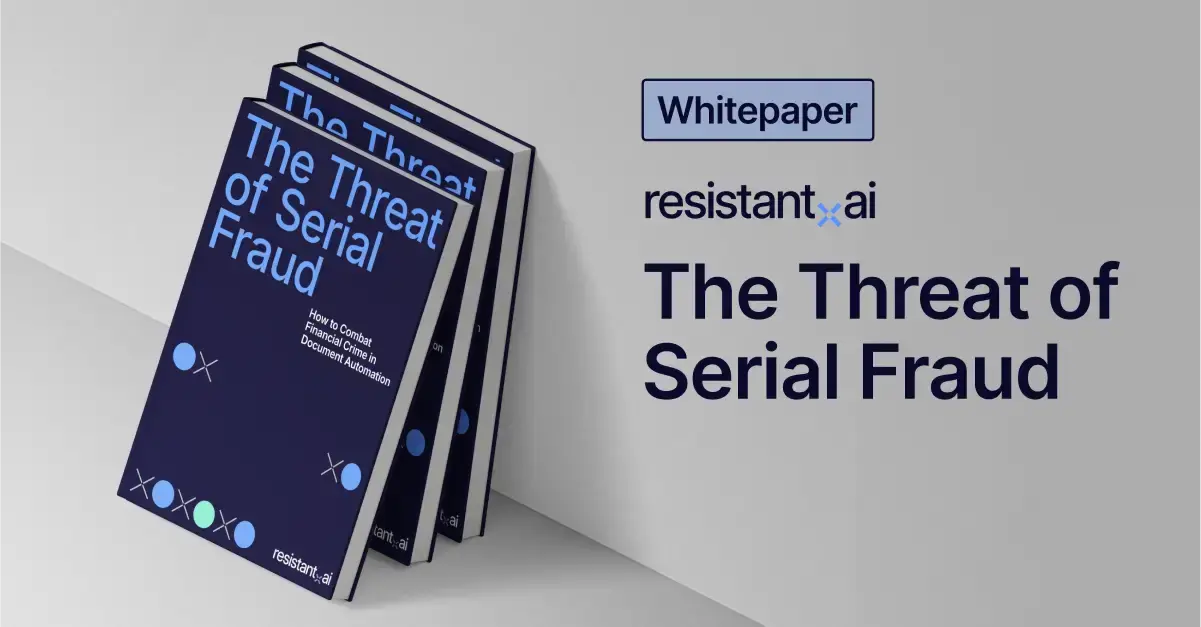How to spot fake bills of lading



Bill of lading fraud is nothing new in 2025.
Take the Trafigura fiasco from a couple years ago for example. They lost $600M in a nickel scam and tried to pass off some of the losses to Hyphen Trading using fraudulent bills of lading, leading to a $8.4M lawsuit filed against them.
Unfortunately, this is all too common in the trade finance industry. Forged or falsified bills of lading can conceal missing cargo or incorrect products usually worth far less.
Read on to learn what bills of lading are, how they’re being forged, how to spot a fake, and how AI-powered tools can help.
Check out our “how to spot fake documents” blog to learn about more common document forgeries.
What are bills of lading?
A bill of lading (BoL or B/L) is a legal document issued by a carrier to a shipper that serves three core functions:
- A receipt for the goods being transported.
- A document of title to the goods.
- A contract of carriage outlining the terms of transport
In trade finance, BoLs verify that a shipment was dispatched, can be used as collateral for financing, and enable lenders to control the release of goods until payment terms are met.
Despite variations across logistics providers, most bills of lading follow a consistent format. They include details such as:
- Shipper details
- Consignee information
- Carrier details
- Cargo description
- Shipment information
- Freight costs
- Bill of lading number
- Terms and conditions
- Declaration of value
- Signatures
These standardized fields allow banks and regulators to process them reliably across jurisdictions.
Bills of lading function similarly to "proof of shipment" in trade finance, much like a pay stub or tax return serves as proof of income in personal lending. They're evidence that the goods underlying the loan have been shipped, making the transaction legitimate and the collateral real.
An example of a bill of lading for illustrative purposes only
Why are bills of lading important?
Bills of lading (BoL or B/L) are critical documents in international trade, logistics, and finance. They provide legal and operational assurance that goods have been shipped, received, and accounted for throughout their journey.
Beyond simply tracking cargo, a BoL serves as evidence of ownership, delivery conditions, and shipment compliance. Their significance for document verification cuts across several key areas:
- Trade finance. Banks and financial institutions rely heavily on bills of lading to issue letters of credit and release payments. A valid BoL indicates that shipment terms have been met, enabling safe financing of global transactions.
- Logistics and shipping. Freight forwarders and carriers use BoLs to verify shipment contents, track cargo movements, and manage liability for lost or damaged goods. Without accurate bills of lading, disputes can quickly arise, disrupting supply chains.
- Customs and compliance. Customs agencies worldwide require BoLs to verify cargo details, origin, and destination, ensuring compliance with international trade laws and tariffs.
- Insurance and claims management. Insurance providers rely on BoLs to assess risk, determine coverage, and validate claims related to shipment loss or damage.
- Legal protection and dispute resolution. In cases of disagreement between shippers, carriers, and recipients, a BoL serves as a legally binding document detailing shipment responsibilities, terms, and agreements.
Because BoLs carry significant financial, logistical, and legal implications, their authenticity and accuracy are paramount.
How do fraudsters create fake bills of lading?
Bad actors create fake or forged bills of ladings in one of four ways:
- Alter real BoLs: The most accessible way is to use online editing tools or PDF editors to modify an existing bill of lading. Fraudsters alter details such as the consignee’s name, shipment description, and dates while replicating the original format and signatures to produce authentic-looking BoLs.
- Use blank BoLs: Pre-made, blank bills of lading with modifiable fields to create a fake one. Unfortunately, these templates are easy to find with simple online searches.
- Duplicate BoLs: Fraudsters issue multiple legitimate-looking bills of lading for a single shipment (or a non-existent one) then sell these duplicate documents to multiple unsuspecting buyers or use them to obtain trade financing from different banks. Each buyer or lender believes they're financing or securing ownership of the cargo, allowing fraudsters to unlawfully secure multiple payments or loans against the same set of goods.
- Collude with insiders: Work with employees within shipping or logistic companies to provide them access to legitimate bills of lading. With a genuine copy on hand, it makes it easy for fraudsters to add in details, or claim ownership and prove ownership of cargoes.
If you’d like to learn more about fraudster forgery tactics, check out our “Types of fraud” blog.
Understanding fake bills of lading
Bill of lading fraud is somewhat complicated to follow thanks to all the parties involved. The documents are issued by carriers, but fraud can occur at either end of the trade deal.
To understand how they work (and how to spot fraud within them), we need to analyze who’s involved, who’s committing the fraud, when carriers become liable, and why surface-level fraud checks don’t always get the job done.
How do bills of lading work and who’s involved
To understand how bills of lading are used for fraud, first we need to understand how they work. The process involves 6 key parties: the seller, buyer, seller’s bank, buyer’s bank, carrier, and (usually) a freight forwarder.
- Step 1. The seller (also known as the shipper) prepares the goods for export and hands them over to the Carrier (e.g. shipping line or airline). In return, the carrier issues a bill of lading.
- Step 2. The seller submits the bill of lading to their bank to initiate payment (often under a letter of credit or similar trade finance structure). The seller’s bank forwards the bill of lading and any other required documents to the buyer’s bank. The buyer then receives the BoL (either by making payment or accepting future payment terms) which gives them the right to claim the goods.
- Step 3. The buyer presents the BoL to the carrier (typically at the destination port). The carrier releases the goods to the buyer.

Here's how each role fits into the Bill of Lading lifecycle.
Where the freight forwarder fits in: A freight forwarder sits mostly in Step 1, although their influence can span across all three steps:
- Before shipment. They coordinate logistics, book transport with carriers, prepare export paperwork, and may arrange pickup.
- At the time of shipment. They can act as the shipper of record on behalf of the seller and may issue their own house bill of lading.
- After shipment. They provide tracking, liaise with customs, and can help the buyer with import procedures and delivery.
The key distinction between the carrier and the freight forwarder is that the carrier physically moves the goods, while the freight forwarder organizes the movement and handles documentation.
In many transactions, the seller never deals directly with the carrier. The freight forwarder manages everything on their behalf.
Who commits bill of lading fraud
While a bill of lading may look official, the real risk lies in who’s behind it. Most B/L fraud isn’t the work of carriers. Shippers (sellers), freight forwarders (middle men who arrange carriers for sellers and buyers), or opportunistic third parties are usually responsible.
- Seller-driven fraud. Often involves misdeclared weight, cargo type, port, or even issuing multiple originals to sell the same cargo twice. Genuine goods may be replaced with junk, or the shipment never actually happens. The carrier typically issues B/Ls based on shipper-supplied data and may rely upon official weight verification (VGM), but carriers are rarely the primary culprits.
- Freight forwarder-driven fraud. Freight forwarders issue fake house bills of lading (HBLs) for shipments that never existed or tampering with shipping details. They may falsify departure or delivery dates, claim the cargo was loaded when it wasn't, or even forge the carrier’s master bill of lading. Because they're trusted to manage logistics and documentation, fraud at this stage can be hard to spot.
- Third-party-driven fraud. Bad actors not involved in the real transaction may intercept or fabricate B/Ls to impersonate a seller or broker. These scams often target inexperienced buyers via email or trading platforms, using forged documents and fake company identities to solicit upfront payments. Because B/Ls can appear official, buyers unaware of how to verify them are especially vulnerable.
When carriers might become liable
Courts have repeatedly ruled that carriers generally can rely on the shipper’s declared details — unless there’s known or obvious discrepancies (e.g. a very large weight mismatch between VGM and the B/L).
In such cases, carriers might be obliged to either flag or clause the B/L, or even refuse to issue a clean B/L altogether. If they fail to act when they should, liability may arise.
Stronger fraud detection focuses on chain and behavior
Rather than relying solely on how a bill of lading looks, effective fraud detection focuses on verifying the origin, behavior, and authenticity of the document:
- Prefer master B/Ls when possible. These are issued directly by vessel-operating common carriers (VOCCs), such as Maersk or MSC, and follow standardized formats. They're easier to authenticate using known templates, logos, reference fields, and issuing systems.
- Request draft B/Ls and supporting documentation early. Documents like mate’s receipts, inspection reports, or certificates of origin can help cross-check shipment details and identify inconsistencies in timing, location, or cargo type.
- Use behavioral and chain-based analysis. Patterns such as repeated template reuse across different entities, unusual submission timing, or mismatches between declared weight and verified gross mass (VGM) can signal fraud that visual inspection alone might miss.
Classic forgery signs still matter
Visual clues can help confirm suspicions, especially when comparing a questionable document to a legitimate carrier-issued sample:
For common routes and high-volume carriers, legitimate examples from carriers like Maersk, Mediterranean Shipping Company (MSC), CMA CGM, COSCO Shipping Lines, or Hapag-Lloyd can serve as useful references when verifying a bill's structure, fields, and signature blocks.
Here are the most common indicators to look for:
5 signs of a forged or fake bill of lading
Detecting a fake bill of lading manually requires a sharp eye and familiarity with specific real-world red flags. Advanced fraud techniques can create convincing forgeries, but certain subtle mistakes often give away fraudulent documents.
We recommend always using an AI-powered, automated document fraud detection software. However, if you’re still reviewing manually, here’s what to watch for:
1. Inconsistent formatting
Legitimate bills of lading have consistent layouts, clear font alignment, and standardized sections issued by shipping carriers. Fraudulent BoLs frequently show formatting irregularities due to manual alterations.
- Font and structural misalignments. Mismatched or inconsistent font sizes, poorly formatted sections, especially around shipment details, container numbers, or consignee addresses.
- Awkward spacing and misaligned text. Uneven margins, overlapping cargo descriptions, or inconsistent spacing in fields such as "Port of Loading," "Destination Port," and "Vessel Name."
- Shipping company logos. Shipping company logos or carrier stamps that appear blurry, stretched, or digitally manipulated.
- Missing or incorrect watermarks. Known international carriers (e.g., Maersk, MSC) typically embed watermarks; absence or inconsistency suggests tampering.
2. Incorrect or misleading information
Fraudulent bills of lading often contain logically flawed or inaccurate details that are easily disproven upon close inspection.
- BoL and supporting documents. Contents on the bill of lading do not align with dates on supporting documents (e.g., mate’s receipt, letters of credit, or survey reports), often altered to evade contractual obligations or hide shipment delays.
- False shipment descriptions. Cargo condition inaccurately listed (e.g., damaged steel falsely described as pristine) to deceive insurers or buyers.
- Invalid or nonexistent vessel names. Listed vessel names do not match shipping schedules available on maritime tracking services (e.g., MarineTraffic).
- Incorrect port details. Port names or codes misrepresented to bypass import quotas, sanctions, or customs scrutiny. Costly deliveries to the same warehouse, jetty, or port within a short time frame may also indicate trade finance loan fraud. In a previous case, two separate shipments of marble valued at $4M and $5M were delivered and stored in a tiny town within a day — a highly unlikely scenario.
- Inconsistent signatures. Signatures of shipper, carrier, or receiver differ dramatically from previous authenticated documents or are suspiciously generic.
3. Bad math and uncharacteristic figures
Fraudsters commonly make errors in cargo weights, quantities, or financial figures, reflecting unrealistic or careless forgery.
- Incorrect shipment weight. Cargo weight listed on the bill does not match actual weight verified by inspection or related cargo documents.
- Illogical cargo valuation. High-value cargo deceptively represented as lower-value items (e.g., a $20M copper cargo falsely documented as granite to disguise theft).
- Impossible shipping timelines. Cargo delivery times shown are logistically impossible based on vessel speeds and distance between ports.
- Rounded or improbable cargo figures. Weight, dimensions, or cargo values are suspiciously rounded or perfectly even, contrary to typical shipping documentation.
- Conflicting data with associated documents. Figures in the BoL differ significantly from those reported in insurance papers, invoices, or customs declarations.
4. Document inconsistencies
Fraudulent bills of lading frequently contain internal contradictions or irregularities that authentic documents never would.
- Cargo listed as "shipped" when not loaded. Shipments marked "shipped on board" that were never physically loaded, confirmed by direct communication with carriers or port authorities.
- False under-deck statements. Cargo listed as shipped "under deck" but actually transported above deck, or delivery documents indicating normal cargo while the BoL references "stowaway," especially common in Chinese steel exports attempting to conceal damage.
- Absent or suspicious forwarder information. Missing forwarder names or contact details, often indicative of double brokering schemes
- Double brokering schemes. Freight broker reassigns a shipment to another broker without the shipper’s knowledge, often leading to payment disputes, lost cargo, or service failures).
- Circular trading patterns. Evidence of repeated transactions involving the same cargo among consistent groups of companies, artificially inflating trade volume.
- Port loading discrepancies. Documented port of loading differs from actual shipment routes or established carrier operations, used to evade regulatory scrutiny.
5. Metadata discrepancies
Digital bills of lading can betray fraud through embedded file metadata, exposing hidden signs of tampering and forgery.
- Suspicious file creation dates. Document metadata shows a creation date that post-dates the claimed shipping or loading date, indicating backdating or forgery.
- Editing software traces. Metadata reveals document creation or editing through non-industry-standard software like Photoshop or Microsoft Word rather than professional logistics software.
- Locked or restricted documents. Digital BoLs with metadata deliberately locked or restricted, designed to prevent examination of editing history or document properties.
- Unusual language or region settings. Metadata indicates settings (e.g., “English - US” for European shipments) inconsistent with the declared shipment’s origin or destination.
- Embedded images instead of text layers. Authentic BoLs are typically text-based PDFs; image-based PDFs often indicate a screenshot-based forgery.
Disclaimer: As fraud techniques evolve from simple edits to AI-driven document generation, relying solely on manual verification is no longer safe. Scammers now produce near-perfect BoL forgeries at scale, requiring automated, AI-powered fraud detection solutions to reliably secure your operations.
How can you detect a bill of lading fraud?
Detecting fraud in bills of lading (BoLs) can be challenging. From document volumes to human error, there’s a lot of possibilities for fakes to slip through. To effectively identify fraudulent activity, companies should leverage a combination of technology and human expertise. This dual approach enhances accuracy and strengthens protection against trade finance fraud.
Here are three key strategies to begin with:
Conduct manual reviews
Beyond using the visual cues we mentioned above, you can start preventing fake bills of lading from infiltrating the system by cross-referencing them with shipping documents and official databases.
However, this is only a starting point. Manual reviews are time-consuming and prone to human error. Relying on them alone can lead to more fraud and slower processes.
That being said, they still have a valuable place in your fraud defense. Here’s how to do it:
- Cross-reference. Compare shipment details across warehouse receipts, invoices, airway bills, packing lists, etc.
- Contact the shipping firm: Directly contact the logistics company. This can help verify a cargo’s location and proof of ownership swiftly.
- Track BoLs online: Check the container’s location through third-party services and databases such as GoComet. This allows lenders to verify the shipment’s movement and ensure that it tallies with all shipping documents.
- Quality check: Since shipments act as collateral for trade financing, lenders should conduct quality checks by obtaining a sample from the shipment to confirm that the goods listed in shipping documents match the actual cargo.
Use an AI-driven document fraud detection system
Deploying a dedicated AI document fraud detector can help assess the authenticity of BoLs with more speed and accuracy, giving greater confidence for decision-making, and allowing you to process many more documents. Here’s are some of the benefits of choosing an AI-driven solution:
- High accuracy. An AI-powered document fraud detector can detect subtle signs of forgery, fake templates, and other fraud indicators with higher accuracy than their human counterparts.
- Support multiple document formats: AI-driven document fraud detection software supports multiple formats, such as PDF, JPEG, and PNG, and document types from any country.
- Clear verdict: A high-quality AI document fraud detector provides clear verdicts that do not need further interpretation, enabling you to approve or deny bills of lading based on clear, evidence-backed results to minimize potential risks.
- Explainable results: For auditors and stakeholders to know they’re getting the right outcomes.
- Matches your risk appetite: A configurable AI-driven document fraud detector helps align verification processes with their risk appetite, providing adaptive decisioning to only approve bills of lading that meet business criteria and risk tolerance.
Use e-BoL (digital bills of lading)
Switching to digital bills of lading (e-BoLs) helps combat document fraud by authenticating each signature through a secure verification portal, requiring authorized personnel to enter personal identification numbers (PINs).
Additionally, the audit trail function makes e-BoLs difficult to duplicate, modify, or falsify. While e-BoLs are not foolproof, combining them with AI-driven fraud detection software can help to identify serial fraud, reduce vulnerabilities, and minimize the risks of pirated or duplicated e-BoLs.
Conclusion
Bills of lading are foundational documents in global trade — carrying legal, financial, and logistical weight in every transaction. But that same importance makes them a prime target for fraud.
Manual checks and visual inspections aren’t enough anymore. Fraudsters have become faster, better, and more convincing. That’s why companies across trade finance, shipping, and insurance are turning to AI-powered fraud detection tools to stay ahead.
Resistant AI’s document forensics technology analyzes bills of lading and other trade documents for signs of tampering, suspicious patterns, and behavioral anomalies — even when the forgery looks perfect to the human eye.
It integrates into your existing systems, scales with your volume, and delivers verdicts you can trust.
Scroll down to book a demo today.
Frequently Asked Questions (FAQ)
Hungry for more fake bills of lading content? Here are some of the most frequently asked questions about fake bills of lading from around the web.
What’s the difference between bills of lading, invoices, and packing Lists?
Bills of lading, letters of credit, and packing lists are commonly confused because they’re all critical in international trade, but each differs in purpose: bills of lading confirm shipment and ownership, letters of credit guarantee payment, and packing lists detail shipment contents
Bill of lading: A legally binding document issued by a carrier acknowledging receipt of cargo.
- Issued by: Shipping carriers or freight companies.
- Characteristics:
- Confirms goods have been received for transport.
- Acts as proof of ownership, allowing transfer upon delivery.
- Serves as evidence of the contract of carriage.
Letter of credit: A financial instrument issued by banks guaranteeing payment once specified terms are met.
- Issued by: Banks or financial institutions.
- Characteristics:
- Ensures the seller receives payment if they meet agreed-upon conditions.
- Provides security to both buyer and seller by reducing transaction risk.
- Includes conditions linked to delivery timelines and documentation.
Packing list: An itemized document detailing the contents of a shipment.
- Issued by: Exporters or shippers.
- Characteristics:
- Describes packaging and dimensions of goods.
- Used by customs to inspect cargo.
- Does not include price information.
Who needs to check for fake bills of lading?
Fake bills of lading pose significant risks, and vigilance is required by key roles involved in trade verification and logistics processes:
- Customs officers. To validate the authenticity of shipments, preventing smuggling and tariff evasion.
- Freight forwarders. To confirm cargo legitimacy and avoid involvement in illicit shipments.
- Compliance officers. To ensure adherence to international trade regulations and sanctions.
- Financial institutions. Banks and trade finance professionals verifying transactions to avoid fraudulent trade financing.
- Insurance adjusters. Confirming the legitimacy of claims related to lost or damaged cargo.
Is making or using a fake bill of lading illegal?
Yes. Creating, using, or knowingly handling a fake bill of lading is considered fraud in nearly all jurisdictions. In the United States, it can lead to prosecution under federal wire and mail fraud statutes, potentially resulting in heavy fines and imprisonment of up to 20 years.
Internationally, similar penalties exist under laws such as the UK's Fraud Act 2006.
How are fake bills of lading typically used in fraud schemes?
Fraudulent bills of lading facilitate various fraudulent activities, including:
- Trade financing fraud. Securing bank loans by presenting fake documentation of nonexistent or inflated cargo.
- Customs fraud. Evading import duties by misrepresenting cargo contents or origins.
- Cargo theft. Using forged documents to redirect or unlawfully claim shipments.
- Money laundering. Generating false trade transactions to legitimize illicit financial flows.
- Insurance fraud. Fabricating losses using fake documents to collect insurance payouts.
Can fake bills of lading bypass digital verification systems?
Surprisingly, yes. Skilled fraudsters now use advanced forgery techniques, including AI-generated layouts, precise cloning of carrier branding, and manipulation of digital metadata, to bypass basic automated checks.
Advanced, AI-driven verification solutions that analyze structural anomalies are becoming increasingly critical to identifying sophisticated fake bills of lading.
Can a bill of lading be forged?
Yes, a bill of lading can definitely be forged. In some instances, it can be completely falsified as part of a trade finance lending fraud scheme to obtain illicit funds. Fraudsters may alter details, forge signatures, or fabricate entire documents to deceive consignees, shippers, and lenders.
What makes a bill of lading valid?
A bill of lading is valid when it contains all relevant details and is signed by an authorized representative from the seller, shipper, and buyer.
Which bill of lading is not acceptable to a banker?
Short form and blank bills of lading are not acceptable to financial institutions.
What is an unclean, dirty, or foul bill of lading?
A foul bill of lading indicates issues with the shipment, such as damages, incorrect quantities, or discrepancies in descriptions upon inspection.
Can a bill of lading be tracked?
Yes, bills of lading can be tracked through the relevant carrier’s website by entering the BoL or specific container number. For example, this tracker from Maersk.







